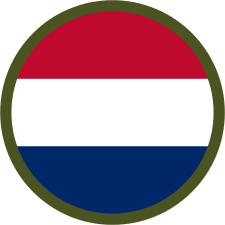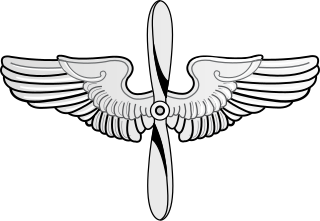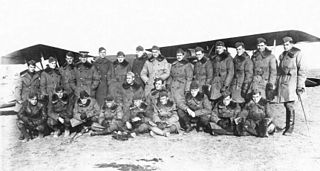
The American Expeditionary Forces (AEF) was a formation of the United States Armed Forces on the Western Front during World War I, comprised mostly of units from the U.S. Army. The AEF was established on July 5, 1917, in France under the command of then-Major General John J. Pershing. It fought alongside French Army, British Army, Canadian Army, British Indian Army, New Zealand Army and Australian Army units against the Imperial German Army. A small number of AEF troops also fought alongside Italian Army units in 1918 against the Austro-Hungarian Army. The AEF helped the French Army on the Western Front during the Aisne Offensive in the summer of 1918, and fought its major actions in the Battle of Saint-Mihiel and the Meuse-Argonne Offensive in the latter part of 1918.

The United States Army Air Service (USAAS) was the aerial warfare service component of the United States Army between 1918 and 1926 and a forerunner of the United States Air Force. It was established as an independent but temporary branch of the U.S. War Department during World War I by two executive orders of President Woodrow Wilson: on May 24, 1918, replacing the Aviation Section, Signal Corps as the nation's air force; and March 19, 1919, establishing a military Director of Air Service to control all aviation activities. Its life was extended for another year in July 1919, during which time Congress passed the legislation necessary to make it a permanent establishment. The National Defense Act of 1920 assigned the Air Service the status of "combatant arm of the line" of the United States Army with a major general in command.

The 81st Readiness Division ("Wildcat") was a formation of the United States Army originally organized as the 81st Infantry Division during World War I. After World War I, the 81st Division was allotted to the Organized Reserve as a "skeletonized" cadre division. In 1942, the division was reactivated and reorganized as the 81st Infantry Division and served in the Pacific during World War II. After World War II, the 81st Infantry Division was allotted to the Organized Reserve as a Class C cadre division, and stationed at Atlanta, Georgia. The 81st Infantry Division saw no active service during the Cold War and was inactivated in 1965.

The 86th Infantry Division, also known as the Blackhawk Division, was a unit of the United States Army in World War I and World War II. Currently called the 86th Training Division, based at Fort McCoy, Wisconsin, members of the division now work with Active Army, Reserve, and National Guard units to provide them with a Decisive Action Training Environment on a yearly basis.

Edward Hammond Johnson was an American football player and coach of football and baseball. He served as the head football coach at the University of Virginia for one season in 1907, compiling a record of 6–3–1. Johnson was also the head baseball coach at the University of Georgia for one season in 1908, tallying a mark of 20–2.

The 99th Aero Squadron was an Air Service, United States Army unit that fought on the Western Front during World War I.

The 103rd Aero Squadron was an aviation pursuit squadron of the U.S. Air Service that served in combat in France during World War I. Its original complement included pilots from the disbanded Lafayette Escadrille and Lafayette Flying Corps. One of those pilots, Paul F. Baer, became the first ace of an American unit in World War I.

The 24th Aero Squadron was a United States Army Air Service unit that fought on the Western Front during World War I.

The 139th Aero Squadron was a United States Army Air Service unit that fought on the Western Front during World War I.

The 22nd Aero Squadron was a United States Army Air Service unit that fought on the Western Front during World War I.

The Organization of the Air Service of the American Expeditionary Force on 11 November 1918, represents its maximum strength in World War I. Units of the Air Service are listed as assigned to the order of battle for that date, which was that of the Armistice with Germany. The first air unit arrived in France in September 1917, while the final air unit reaching the front did so on 9 November 1918. Unit operations began in April 1918. At the armistice, 57,508 officers and men served in the Air Service of the AEF, 24,512 in the Zone of Advance, and 32,996 in the Services of Supply. Of its 6,861 officers, 4,088 were on flying status and 219 were qualified observation balloon aviators. 1,724 of those on flying status and approximately 100 of the balloonists served in combat units.

The 213th Aero Squadron was a United States Army Air Service unit that fought on the Western Front during World War I.

This is the American Expeditionary Forces on the Western Front order of battle. The American Expeditionary Forces (AEF) consisted of the United States Armed Forces that were sent to Europe in World War I to support the Allied cause against the Central Powers. During the United States campaigns in World War I the AEF fought in France alongside French and British allied forces in the last year of the war, against Imperial German forces. Some of the troops fought alongside Italian forces in that same year, against Austro-Hungarian forces. Late in the war American units also fought in Siberia and North Russia.

Base Hospital No. 20, located in Châtel-Guyon, France, was one of the hundreds of Base Hospitals created to treat soldiers wounded during the First World War. It was created in 1916 by the University of Pennsylvania and served the American Expeditionary Forces (A.E.F.) until 1919.

Base Hospital No. 5 was organized by Harvard University and was one of six American Expeditionary Forces (AEF) Base Hospitals loaned to the British Expeditionary Forces (BEF) during the First World War. The personnel started in Camiers at General Hospital No. 11 in June 1917 and then moved to General Hospital No. 13, at Boulogne-sur-Mer to finish out the war.

American Base Hospital No. 57 was an American military hospital formed in Georgia, United States. During the First World War the hospital moved to Paris, where a 1,800-bed hospital was set up to deal with war casualties.

American Base Hospital No. 1 was an American military hospital formed in Bellevue Hospital, New York City, United States. During the First World War the hospital moved to Vichy, France where it was set up to deal with war casualties.
American Base Hospital No. 238 was an American military hospital formed in Rimaucourt, Department Haute Marne, France. This was the last hospital to be created during the First World War.

American Base Hospital No. 36 was an American military hospital formed in Detroit, Michigan. During the First World War, the hospital moved to Vittel in northeastern France where it was set up to deal with war casualties.

American Base Hospital No. 17 was an American military hospital formed in Detroit, Michigan. During the First World War, the hospital moved to Dijon, Department Cote D'Or, France where it was set up to deal with war casualties.



















